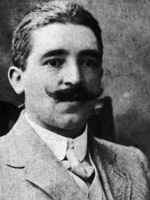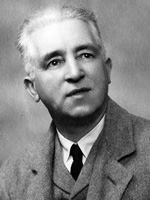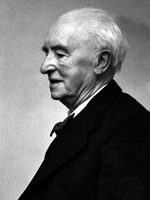Quick links
News
New CD release on Heritage
Symphonies 8, 9, 22 and 24 on Heritage under Myer Fredman
13 February 2023 more…
Brian at the Proms 2022
Premiere Proms performance of Legend, given by Alina Ibragimova
27 April 2022 more…
Brian at the English Music Festival 2022
A recital of songs by Havergal Brian will take place at this year's English Music Festival in Dorchester-on-Thames
11 February 2022 more…
Faust and Symphonies 3/17 CDs now available
Martyn Brabbins' two-disc set of Faust from Dutton and symphonies 3 & 17 under Stanley Pope on Heritage are now available.
11 February 2022 more…
Support us
Havergal Brian’s music
 Brian’s output consists of a large body of orchestral music
including overtures, suites, tone-poems, concertos, and 32
symphonies; five operas; a few large-scale choral and orchestral
works; a great many part-songs, both accompanied and a capella;
a similar number of solo songs; a small quantity of solo piano
music; and a few works in other genres – though several pieces,
major ones included, are missing.
Brian’s output consists of a large body of orchestral music
including overtures, suites, tone-poems, concertos, and 32
symphonies; five operas; a few large-scale choral and orchestral
works; a great many part-songs, both accompanied and a capella;
a similar number of solo songs; a small quantity of solo piano
music; and a few works in other genres – though several pieces,
major ones included, are missing.
Only a few of his most important works have been published, notably by Cranz & Co in the 1930s, in the 1970s by Musica Viva, and currently by United Music Publishers; some even now have never been performed, and many have yet to be heard in public.
Like that of many composers, Brian’s oeuvre can be divided very approximately into a number of creative periods, in his case three. The first lasted from just before the turn of the century to the first years of World War One. Much of Brian’s music from this time is lost, but that which has survived is, generally speaking, characterised by two parallel, contrasting, and often cross-fertilising modes of expression. The first a grotesque, sometimes satirical, vein of humour, as in the English Suite no. 1 (1903–04) and the Comedy Overture Doctor Merryheart (1911–12); the other a mood of grand seriousness, in works like the orchestral tone poem In Memoriam (1910) and the choral By the Waters of Babylon (1905) and The Vision of Cleopatra (1907).
Between these early works and the post-war compositions of his maturity stands the opera The Tigers (1916–19, orchestrated 1928–29). Drawing upon much from his earlier burlesque vein, its action satirises war, patriotism, soldiering, and many other targets in contemporary English society, in a manner unknown in ’serious’ music of its time. But a darker dreamworld repeatedly breaks through the nonsensical surface, and the powerful, elegiac, sometimes nightmarish music of the opera’s substantial ballet sequences foreshadows much that was to come in later years.
 Although humour never entirely left Brian’s music, its manifestation
was far less overt from now on. After writing some of his most
searchingly expressive songs and part-songs (genres he virtually
renounced forthwith), he returned with a new depth and intensity
to his vein of grandeur and seriousness.
Although humour never entirely left Brian’s music, its manifestation
was far less overt from now on. After writing some of his most
searchingly expressive songs and part-songs (genres he virtually
renounced forthwith), he returned with a new depth and intensity
to his vein of grandeur and seriousness.
The work in which he first gave full rein to this became his most famous and notorious – Symphony No 1, The Gothic (1919–27), one of the longest symphonies ever composed, and the work commonly regarded as being written for larger forces than any other known composition. It eventually gave him his greatest public triumph at its first professional performance in 1966, but was most responsible for the damaging and undeserved reputation he acquired as an eccentric composer of huge and unperformable works.
The Gothic is a creation of great seriousness of purpose, in which the inspiration of Gothic architecture, expressed through the Latin text of the Te Deum, combines with many elements from the whole history of Western music from medieval plainsong to the twentieth century to form a vast and immensely varied musical fresco.
The Gothic was a crucial work of Brian’s career. Four more symphonies and a violin concerto – major works by any standards – followed in the 1930s, and his ’second period’ drew to a close with the composition between 1937 and 1944 of Prometheus Unbound – a setting for many soloists, chorus and orchestra of the uncut text of the first two acts of Shelley’s verse-drama. Its full score, however, is the most serious casualty amongst Brian’s lost manuscripts . He seems to have regarded Prometheus as his masterpiece and the climax of his life’s work, but he experienced a renewed onset of creativity in 1948 after four years’ quiescence.
 An early fruit of this ’third period’, the one-movement Symphony
No 8, represented by far his most radical approach to symphonic
form so far. His style, grown to maturity through many years
of private exploration, was now vastly different from that
of any other surviving members of his generation.
An early fruit of this ’third period’, the one-movement Symphony
No 8, represented by far his most radical approach to symphonic
form so far. His style, grown to maturity through many years
of private exploration, was now vastly different from that
of any other surviving members of his generation.
In the 24 symphonies which followed No 8 and which, with his four late operas (Turandot (1949–51), The Cenci (1951–52), Faust (1955–56), and Agamemnon (1957)), were by far the most important products of his ’third period’, he continued his uniquely wide-ranging exploration of the possibilities of the form, in harmony, linear structure and orchestration.
In common with most genuinely creative artists however, this approach seems to have been the natural form of expression for his creative personality, and not a self-conscious imposition. Though he often worked with vestiges of traditional structures, his symphonic language is most often rooted in a highly allusive kind of metamorphosis through developing variation which amounts almost to a musical ’stream of consciousness’.
The products of this language are amazingly diverse in their procedures and atmosphere, and they display a trend to ever-greater concentration of though as well as an almost unparalleled capacity for self-renewal at the most fundamental creative levels. The music of Brian’s 80s and 90s, therefore, far from being a nostalgic swan-song or an old man’s trifling, in fact forms in some ways the most forward-looking, original and satisfying body of music in his entire output.